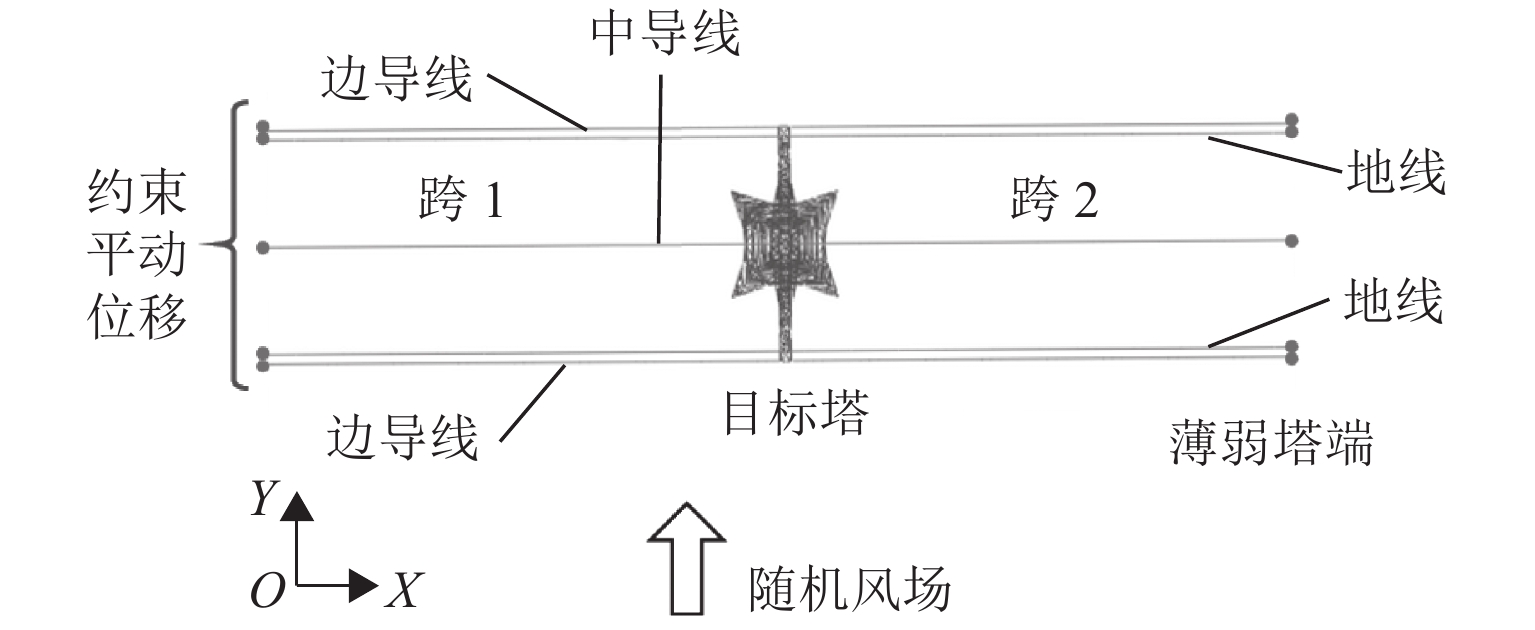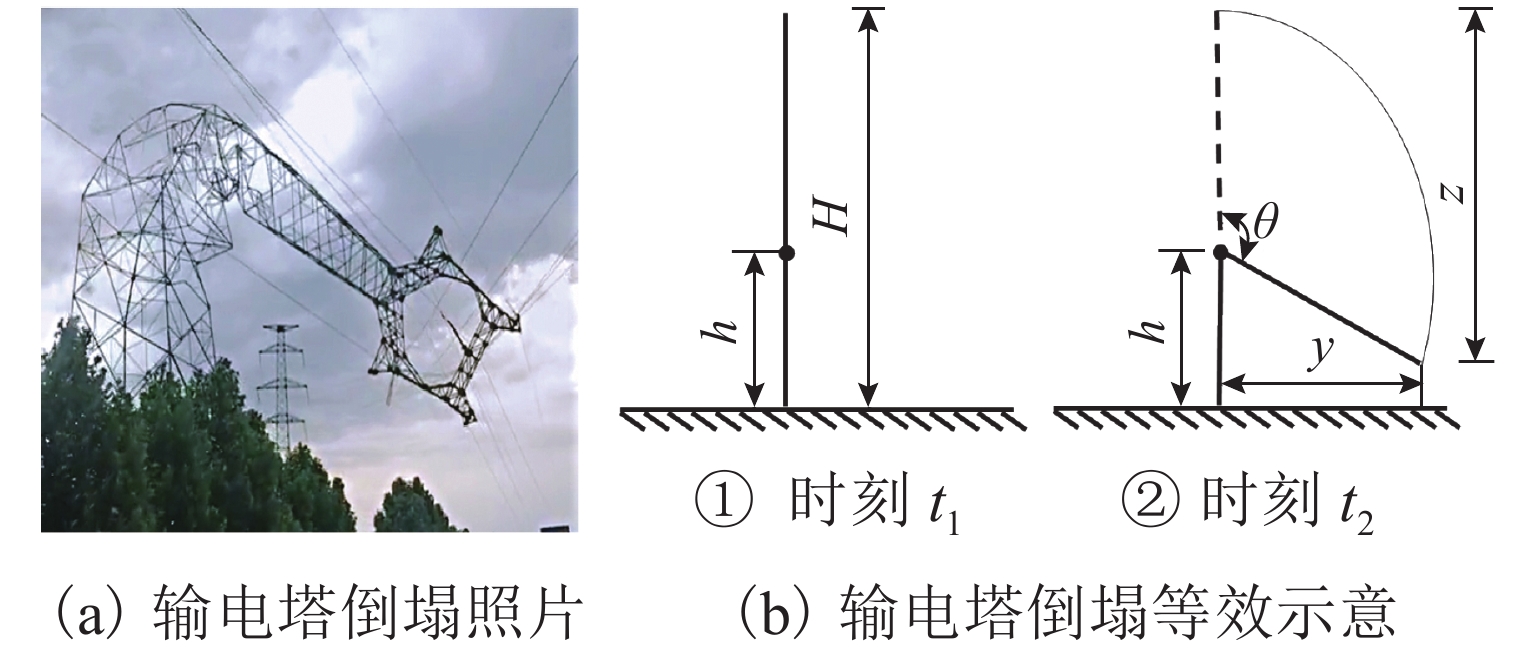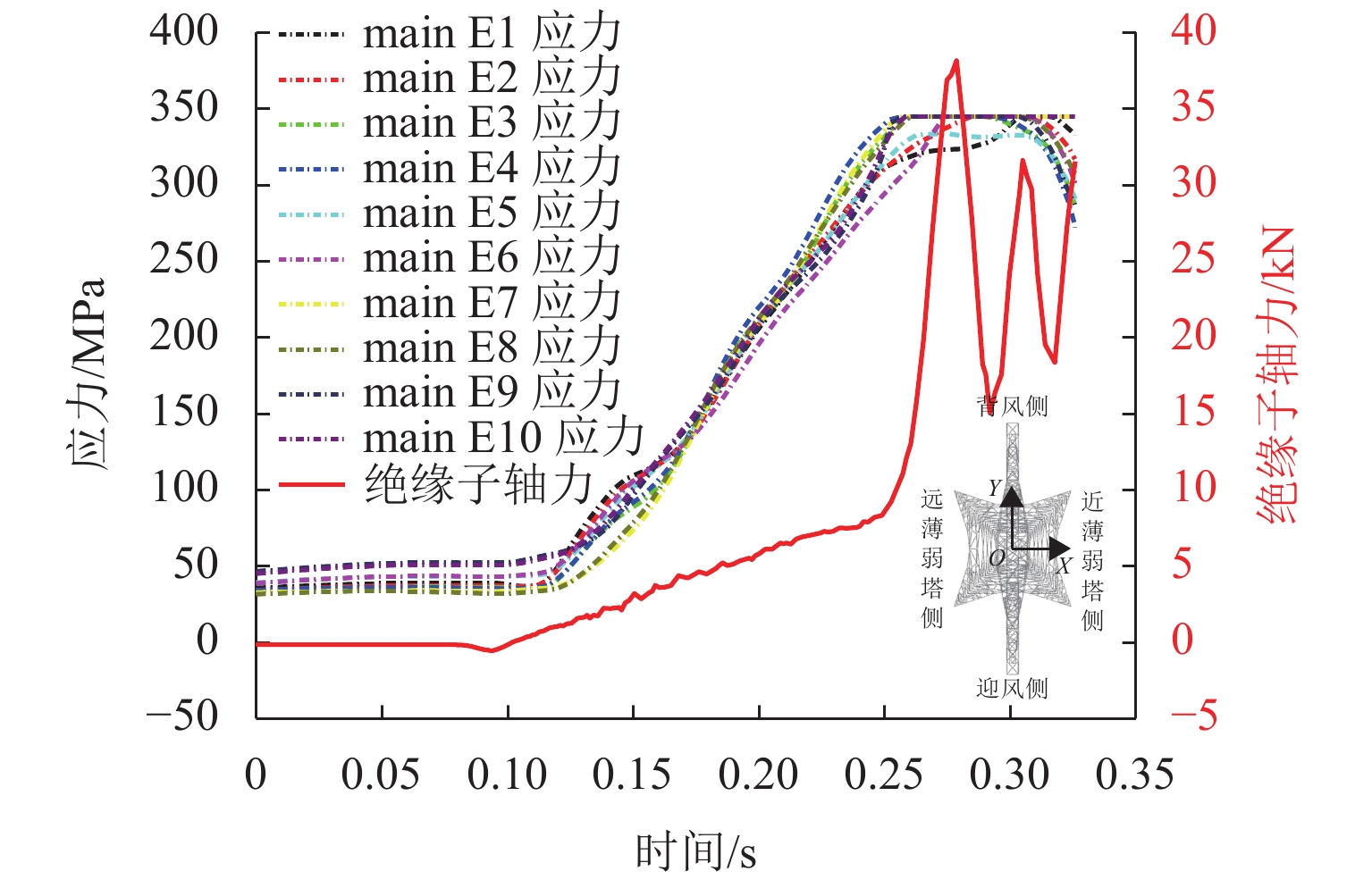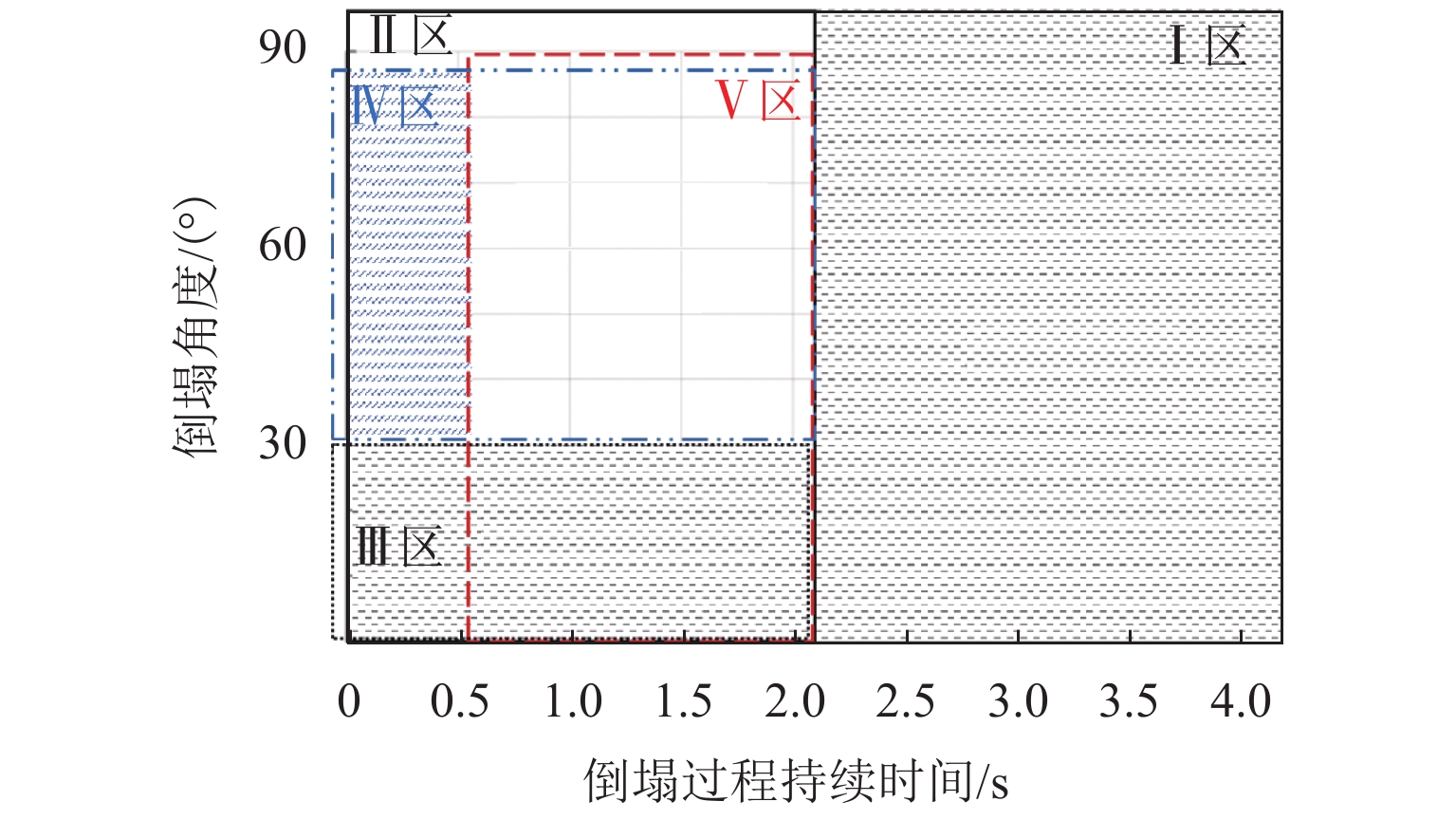Cascading Failure Analysis of Transmission Tower–Line System Under Strong Wind
-
摘要:
为分析强风作用下输电塔线体系连续性倒塌的过程,将已发生破坏的输电塔作为薄弱塔,采用等效位移的方式考虑薄弱塔倒塌对挂线点空间位置的影响,计算相邻输电塔(目标塔)在薄弱塔多组倒塌特征变量组合工况下的响应和破坏特征,确定对目标塔具有最大影响的薄弱塔倒塌特征变量. 结果表明:在发生连续性倒塌时,目标塔的破坏包括近薄弱塔侧的塔身破坏和塔头破坏2种形式;目标塔近薄弱塔侧背风面主材应力比最高,斜材应力比一直较低;塔身下部斜材失稳与主材应力的持续增大是目标塔整体倒塌的最直接原因;薄弱塔的倒塌过程持续时间是目标塔是否破坏的主要控制变量.
Abstract:In order to analyze the cascading failure of the transmission tower–line system under strong wind, this paper took the collapsed transmission tower as the weak tower and used equivalent displacement to consider the influence of weak tower collapse on the spatial location of suspension points. The responses and failure characteristics of the adjacent transmission tower (target tower) under multiple combined groups of the weak tower collapse parameters were calculated, and the weak tower collapse parameters with the greatest influence on the target tower were determined. The results show that when cascading failure happens, the failure of the target tower includes two types, the failure of the tower body near the weak tower and the failure of the tower head. The main bracing on the leeward side of the weak tower has the highest stress ratio. The stress ratios of diagonal bracings are always low. The most direct causes of the overall collapse of the target tower are the instability of diagonal bracings at the lower part of the target tower and the continuous increase in stress of the main bracing. The duration of the weak tower collapse is the main control variable for the failure of the target tower.
-
Key words:
- transmission lines /
- distributed wind /
- cascading failure /
- numerical simulation /
- parameter analysis
-
输电塔与导线地线力学模型的建立与简化分析方法的推进是研究输电线路极限承载力的基础[1-3],输电塔线体系风荷载特征[4-6]、在随机风场下的响应分析[7]以及失效模式[8-9]等是该领域关注的重点课题. 虽然可以通过构件试验[10]与风洞试验[11-12]研究输电塔杆件承载力以及输电塔线体系的风致响应特征,但动力激励下的输电塔体系耦联效应和响应特征更加复杂,与静力情况存在差异[13],耦联效应在输电线路风致破坏中的影响程度和作用机理仍不明晰.
不同原因下的输电塔破坏位置会存在塔头破坏、塔身不同高度处的杆件破坏和塔腿处的破坏等多种形式,对相邻输电塔的影响程度也会不同. 输电塔塔头、塔身出现破坏后,可能导致破坏位置以上的部分产生显著弯折;塔腿区域出现破坏后,可能会整体发生侧倒. 输电塔的振动与倒塌通过导线地线对相邻输电塔产生影响,常采用数值模拟方法通过引入材料损伤[14]或非线性单元优化[15]的方法分析连续性倒塌过程. 目前,此领域的相关研究较多关注强风地震等外激励对输电塔线体系连续性倒塌的影响,针对连续性倒塌过程中输电塔之间的影响研究仍较为缺乏.
本文将输电塔线体系中先发生破坏的输电塔作为薄弱塔,将与其相邻的输电塔作为目标塔,采用等效位移的方式考虑薄弱塔破坏对挂线点空间位置的影响,计算在薄弱塔倒塌破坏点高度、倒塌角度和倒塌过程持续时间等特征变量的多组组合工况下的目标塔响应,从薄弱塔倒塌对目标塔影响的角度,分析连续性倒塌过程中目标塔的响应和破坏特征.
1. 输电塔线体系基本信息
本文采用某500 kV输电塔线体系中的酒杯型输电塔作为研究分析的原型,设计风速为30 m/s(20 m高度处),设计档距400 m. 此输电塔由Q235和Q345 2种钢材的角钢构成,其主要尺寸信息以及导线地线的挂线点位置如图1所示. 图中:H1~H9为非触地工况破坏点位置;D1~D7为触地工况破坏点位置. 输电塔上悬挂有2根地线(OPGW-120)和3根四分裂导线(JL/LB20A-300/40),其中,2根边导线通过Ⅰ形绝缘子串悬挂于两侧横担外端,1根中导线通过Ⅴ形绝缘子串悬挂在输电塔的塔头窗口处. 输电塔线体系的材料属性如表1、2所示.
表 1 输电塔材料Table 1. Material of transmission tower输电塔 屈服强度/MPa 屈服应变/% 本构模型 Q235 235 0.15 理想弹塑性 Q345 345 0.15 理想弹塑性 表 2 输电线材料Table 2. Material of transmission line输电线 综合截面/mm2 弹性模量/MPa 线密度/(kg•km−1) 地线 118.9 123 631.00 导线 338.9 69 1085.50 基于此输电塔线体系的工程信息,钢材采用理想弹塑性双折线本构模型,在ABAQUS中建立数值模型,采用材料阻尼的方式考虑0.01的钢结构阻尼比. 分别采用B31单元和T3D2单元模拟输电塔的角钢杆件和导线地线绝缘子,并为导线地线相应的单元设置不能受压特性. 通过约束塔脚点的全部自由度来模拟完全固定连接. 导线地线分别与绝缘子和输电塔铰接连接.
为便于分析薄弱塔对目标塔的影响,暂不考虑输电线路中的其他输电塔,建立包含目标塔及其前后两跨线的单塔两线有限元模型,前后档距均取为400 m,结构体系及风场方向如图2所示. 将与薄弱塔相连接的导线地线端点记为薄弱塔端,采用薄弱塔端产生端部位移的方式考虑薄弱塔倒塌对挂线点空间位置的影响.
2. 输电塔线体系连续性倒塌工况
2.1 薄弱塔倒塌等效方式
薄弱塔倒塌的等效方式如图3所示. 将薄弱塔倒塌视为直杆绕破坏点发生弯折,薄弱塔倒塌状态S用3个特征变量进行描述,S=[h θ T]. 其中:h为倒塌破坏点高度,h∈[0, H),H为输电塔总高度;θ为倒塌角度,θ∈(0, 180°);T为倒塌过程持续时间. 记薄弱塔开始倒塌时刻为t1,倒塌结束时刻为t2,则有T=t2−t1. 基于T=0.5,1.0,2.0,3.0 s 4种工况进行计算分析,并通过插值的方式考虑其他持续时间工况的影响. 采用图3所示的方式计算薄弱塔倒塌造成的挂线点位移变化近似值. 当薄弱塔向垂线路方向倒塌时,水平向和竖向的位移变化分别记为y和z.
2.2 薄弱塔倒塌工况
薄弱塔倒塌3个特征变量的不同组合形成多组薄弱塔倒塌工况,可分为薄弱塔触地工况和薄弱塔非触地工况2类.
2.2.1 薄弱塔倒塌触地工况
当薄弱塔发生破坏的杆件距离地面较近,即H−h>h时,薄弱塔倒塌破坏点之上的长度大于倒塌破坏点高度. 此时,薄弱塔倒塌点之上的部分足够长,薄弱塔的塔头能够在倒塌后处于触地状态. 不考虑薄弱塔倒塌后塔头撞击地面产生的变形以及塔身倒塌破坏区域杆件折叠导致的高度折减,可近似将竖向的位移变化z取值为输电塔最下层横担底面到地面的垂直距离,水平向的位移变化为y=(H−h)× cos(θ−π/4).
仅考虑薄弱塔倒塌破坏发生在塔身的情况,各交叉斜材端点的标高已在图1中标出. 参考各交叉斜材端点的标高,将输电塔倒塌破坏点的高度取为h=10 + 2i, i=0,1,…,6,各破坏高度所对应的薄弱塔挂线点等效位移值如表3所示,相对应的破坏点(D1~D7)已在图1中标出.
表 3 薄弱塔倒塌触地工况Table 3. Weak tower collapse and ground contact condition破坏点 h/m θ/(°) T/s y/m z/m D1 22.0 156.4 0.5,1.0,
2.0,3.09.59 −42.00 D2 20.0 140.3 16.61 −42.00 D3 18.0 130.0 21.45 −42.00 D4 16.0 122.2 25.38 −42.00 D5 14.0 115.9 28.77 −42.00 D6 12.0 110.7 31.81 −42.00 D7 10.0 106.1 34.58 −42.00 2.2.2 薄弱塔倒塌非触地工况
当薄弱塔发生破坏的杆件距离地面较远,即H−h<h时,薄弱塔倒塌破坏点之上的长度小于倒塌破坏点高度. 此时,薄弱塔的塔头不能触地,在薄弱塔杆件和导线地线的牵拉下斜挂于薄弱塔上,如图3(a)所示. 对于此类工况,仍采用图3(b)所示的方法,将薄弱塔倒塌视为直杆绕破坏点发生弯折,计算薄弱塔倒塌破坏造成的导线地线在水平向和竖向的位移变化. 考虑薄弱塔倒塌角度θ =30°,60°,90°,倒塌破坏点H1~H9各工况下特征变量取值为h=26.0,24.0,22.0,20.0,18.0,16.0,14.0,12.0,10.0 m, T=0.5,1.0,2.0,3.0 s.
2.3 薄弱塔倒塌时的随机风场
对于薄弱塔倒塌的各个工况,均分别考虑90°风攻角下的25 m/s和20 m/s两种风速情况. 为考虑风场与薄弱塔倒塌的共同作用,在薄弱塔发生破坏时刻之前,先在输电塔线体系模型中引入随机风场,并进行60 s塔线响应计算,使目标塔处于振动状态.
传统的脉动风速能量谱在建立随机风场的过程中需引入大量的随机变量,计算工作量大,并且局限于二阶矩数值特征建模,所以,本文采用阎启等[16]提出的三谱叠加方法模拟随机风场,基于Fourier幅值谱、基准相位谱和相位差谱,生成可以考虑风场随机性和空间相关性的随机风场. 每根导线地线上的加风点间隔为5 m,加风点位置如图4(a)所示. 以25 m/s工况为例,随机风场在挂线点处的脉动风速时程如图4(b)所示. 在完成60 s随机风场作用下目标塔动力响应计算后,在导线地线的薄弱塔端设置等效位移,同时保持输电塔线体系仍受到随机风场作用,计算各个工况下目标塔在薄弱塔倒塌30.00 s 内的响应特征.
3. 输电塔线体系连续性倒塌特征分析
3.1 目标塔破坏类型
在各个工况下,目标塔的破坏可分为2类:一类是以目标塔靠近薄弱塔一侧的杆件失效为特征的塔身破坏,如图5(a)所示;另一类是以地线支架弯折失效为特征的塔头破坏,如图5(b)所示.
基于交叉斜材与主材连接节点附近单元的应力数据,分析目标塔的响应特征. 分别用main (红色圆点)和diag (蓝色圆点)标记主材和斜材的相应单元,沿高度方向依次记为E1~E10,其位置示意如图6所示. 对于目标塔4个塔身平面上的杆件,以目标塔中心为坐标原点,X轴正向的塔身面靠近薄弱塔. 本文将位于目标塔此面的杆件称为近薄弱塔侧,X轴负向的塔身面称为远薄弱塔侧;Y轴正向为目标塔背风侧,Y轴负向为迎风侧.
3.1.1 目标塔塔身破坏类型特征分析
为清晰反映各时刻输电塔杆件应力状态与绝缘子轴力的对应关系,采用双纵轴的形式将2类变量绘于同一张图中,如图7和图8所示. 由于导线地线存在初始弧垂,所以在最初的 0.11 s时间段内,绝缘子端部轴力(图8中的红色实线)几乎无变化,此段曲线对应着目标塔与薄弱塔之间导线地线在端部位移影响下弧垂逐渐减小直至导线地线张紧的过程.
随着薄弱塔的倒塌,导线地线端部位移增大,绝缘子张力逐渐增大. 在此过程中,近薄弱塔侧的目标塔背风面主材B应力在短时间内迅速增大. 在同时间段内,目标塔远薄弱塔侧迎风面主材D的应力变化特征与主材B相似,目标塔近薄弱塔侧背风面主材A和远薄弱塔侧迎风面主材C应力一直较低.
在连续性倒塌过程中,目标塔近薄弱塔侧与主材B相邻的斜材单元应力如图8所示. 斜材单元位置已在图6中标出. 只有目标塔塔身下部的斜材单元E9出现显著的应力增大现象. 其余远离薄弱塔一侧的目标塔斜材应力虽然存在显著波动,但一直不超过100 MPa. 在此过程中,目标塔远薄弱塔侧的斜材应力也呈现相似趋势.
对于目标塔塔身破坏的工况,连续性倒塌过程中关键变量的时程图如图9所示. 从薄弱塔开始倒塌的0.11 s内,目标塔与薄弱塔之间导线地线在端部位移影响下弧垂逐渐减小直至导线地线张紧,各变量均几乎无变化. 如图9(a)所示,在[0.11, 0.16] s内,目标塔远离薄弱塔一侧的导线地线弧垂逐渐减小,表现为绝缘子端部位移的逐渐增大,以及导线固定端的轴力因突然张紧而出现陡增和波动衰减. 如图9(b)所示,在[0.16, 0.24] s内,目标塔塔身下部靠近薄弱塔侧的斜材面外变形逐渐增大并发生跳跃型失稳,随后,目标塔远薄弱塔侧斜材也发生跳跃型失稳. 在此过程中,目标塔主材B中各单元的应力(图9(b))以及单元main E9处的变形(图9(c))持续增大. 在时间0.25 s时,主材变形减缓引起目标塔与导线间的瞬间牵拉,绝缘子轴力呈现突增和波动衰减(图9(c)),目标塔发生倒塌破坏.
3.1.2 目标塔塔头破坏类型特征分析
对于目标塔塔头破坏工况,地线支架端点位移和绝缘子轴力如图10所示. 与塔身破坏相似,在薄弱塔开始倒塌的0.10 s内,地线支架端部的位移几乎无变化. 随着端部位移的增大,导线地线张紧,塔头各杆件应力显著增大,并在0.26 s时引起绝缘子轴力的小幅度波动. 随着输电塔塔头变形的增大,压力向下的传递受到影响,塔身各杆件单元应力开始减小. 在0.42 s和0.59 s时刻目标塔地线支架端部位移曲线斜率发生突变时,绝缘子轴力会产生相应的突变和波动. 在 0.42 s时,输电塔塔头变形曲线进入平台段,引起目标塔与导线间的瞬间牵拉,绝缘子轴力呈现突增和波动. 在 0.59 s时,目标塔变形发生突变,并导致绝缘子端部轴力大幅波动,发生图5(b)所示的倒塌破坏.
3.2 目标塔应力状态
连续性倒塌过程中,随着薄弱塔的倒塌,导线地线端部出现显著位移. 目标塔会在短时间内承受导线地线的牵拉作用,主材斜材应力发生变化. 将各工况下杆件的实际应力σ与屈服应力σy的比值作为应力比R,即R=σ/σy. 主材、斜材的屈服应力分别取值为345、235 MPa. 在薄弱塔倒塌过程持续时间T=3.0 s工况下,目标塔4根主材的应力比如图11所示. 从图中可以看出,位于目标塔近薄弱塔侧背风面的主材B应力比最高,其次是远薄弱塔侧迎风面的主材D,主材A和主材C的应力比较低. 其他薄弱塔倒塌过程持续时间工况下的目标塔各主材应力比相对大小与图11相似.
3.3 目标塔敏感变量分析
薄弱塔倒塌的3个特征变量对目标塔的影响程度不同,目标塔对特征变量的敏感度可以通过特征变量发生变化时目标塔的破坏状态来判断.
3.3.1 薄弱塔倒塌触地工况
记目标塔非破坏状态为0,破坏状态为1. 在薄弱塔倒塌破坏触地工况中,通过插值云图的方式体现目标塔破坏状态与薄弱塔倒塌特征变量间的关系,如图12所示.
从图12中可以看出:当薄弱塔的倒塌破坏过程持续时间较短,即薄弱塔在1.00 s以内快速倒塌触地时,目标塔易发生破坏,此时,薄弱塔倒塌破坏点高度的影响以及随机风场风速的影响均不明显;当薄弱塔倒塌破坏持续时间较长时,若薄弱塔的倒塌破坏点位于塔身上部,随机风场的影响更明显,较小的随机风场作用下,目标塔可能不会发生破坏.
3.3.2 薄弱塔倒塌非触地工况
在薄弱塔倒塌破坏的非触地工况中,目标塔破坏状态与薄弱塔倒塌特征变量间的关系如图13所示,图中红色虚线框为不同风速下云图差异较大的区域. 薄弱塔倒塌破坏控制参数的主要影响区如图14所示. 从图13中可以看出:薄弱塔的倒塌过程持续时间对目标塔是否发生破坏具有显著影响;当倒塌过程持续时间较长时(图14 Ⅰ区),导线地线能有效缓冲薄弱塔倒塌造成的冲击作用,不易引起目标塔破坏;当倒塌过程持续时间较短时(图14 Ⅱ区),薄弱塔的倒塌角度对目标塔的破坏状态会有显著影响;倒塌过程持续时间较短且倒塌角度较小时(图14 Ⅲ区),目标塔一般不会发生破坏;而倒塌过程持续时间较短且倒塌角度较大时(图14 Ⅳ区),目标塔是否破坏与薄弱塔倒塌破坏点高度显著相关. 当倒塌破坏点高度靠近塔头塔身连接处时,输电塔不易发生破坏;此外,随机风场对目标塔的破坏状态影响只在某个倒塌过程持续时间区间(图14 Ⅴ区)内较为显著,其余区间内不同风场下的目标塔破坏状态差异不大.
4. 结 论
本文采用薄弱塔倒塌等效位移的方式,分析强风作用下输电塔线体系连续性倒塌特征,确定了目标塔破坏类型和对目标塔破坏起显著影响的薄弱塔倒塌特征变量. 主要结论包括:
1) 连续性倒塌过程中,目标塔近薄弱塔侧背风面主材和远薄弱塔侧迎风面主材的应力比显著大于其他主材,目标塔斜材应力比一直较低.
2) 在发生连续性倒塌时,目标塔的破坏包括塔身破坏和塔头破坏2种形式. 塔身下部斜材的跳跃性失稳与主材应力的持续增大是目标塔整体倒塌的直接原因.
3) 薄弱塔的倒塌过程持续时间对目标塔是否发生破坏具有显著影响. 当酒杯型薄弱塔倒塌过程持续时间较短时,薄弱塔倒塌角度是目标塔破坏状态的主要控制变量;当倒塌过程持续时间较短且倒塌角度较大时,薄弱塔倒塌破坏点高度是目标塔是否破坏的主要控制变量.
-
表 1 输电塔材料
Table 1. Material of transmission tower
输电塔 屈服强度/MPa 屈服应变/% 本构模型 Q235 235 0.15 理想弹塑性 Q345 345 0.15 理想弹塑性 表 2 输电线材料
Table 2. Material of transmission line
输电线 综合截面/mm2 弹性模量/MPa 线密度/(kg•km−1) 地线 118.9 123 631.00 导线 338.9 69 1085.50 表 3 薄弱塔倒塌触地工况
Table 3. Weak tower collapse and ground contact condition
破坏点 h/m θ/(°) T/s y/m z/m D1 22.0 156.4 0.5,1.0,
2.0,3.09.59 −42.00 D2 20.0 140.3 16.61 −42.00 D3 18.0 130.0 21.45 −42.00 D4 16.0 122.2 25.38 −42.00 D5 14.0 115.9 28.77 −42.00 D6 12.0 110.7 31.81 −42.00 D7 10.0 106.1 34.58 −42.00 -
[1] 陈波,宋欣欣,吴镜泊. 输电塔线体系力学模型研究进展[J]. 工程力学,2021,38(5): 1-21. doi: 10.6052/j.issn.1000-4750.2020.08.ST07CHEN Bo, SONG Xinxin, WU Jingbo. Advances in mechanical models of transmission tower-line systems[J]. Engineering Mechanics, 2021, 38(5): 1-21. doi: 10.6052/j.issn.1000-4750.2020.08.ST07 [2] 汪之松,刘兴龙,武彦君,等. 考虑SSI效应的输电塔-线体系风振响应简化分析[J]. 西南交通大学学报,2019,54(2): 319-327. doi: 10.3969/j.issn.0258-2724.20170715WANG Zhisong, LIU Xinglong, WU Yanjun, et al. Simplified analysis of wind-induced response of transmission tower-line system considering SSI effect[J]. Journal of Southwest Jiaotong University, 2019, 54(2): 319-327. doi: 10.3969/j.issn.0258-2724.20170715 [3] CAI Y Z, XIE Q, XUE S T, et al. Fragility modelling framework for transmission line towers under winds[J]. Engineering Structures, 2019, 191: 686-697. doi: 10.1016/j.engstruct.2019.04.096 [4] 杨雄骏,黄金山,张建国,等. 基于插值与降维方法的输电塔线体系随机脉动风场有效模拟[J]. 振动与冲击,2021,40(9): 77-83. doi: 10.13465/j.cnki.jvs.2021.09.011YANG Xiongjun, HUANG Jinshan, ZHANG Jianguo, et al. Effective simulation of stochastic fluctuating wind field of transmission tower-line system based on interpolation and dimension reduction method[J]. Journal of Vibration and Shock, 2021, 40(9): 77-83. doi: 10.13465/j.cnki.jvs.2021.09.011 [5] 杨风利,陈兵,许志勇,等. 500 kV长江大跨越输电塔风振系数研究[J]. 中国电机工程学报,2022,42(7): 2542-2556.YANG Fengli, CHEN Bing, XU Zhiyong, et al. Study on wind-induced vibration coefficients of the transmission tower in 500 kV long span line crossing the Yangtze River[J]. Proceedings of the CSEE, 2022, 42(7): 2542-2556. [6] 沈国辉,李保珩,郭勇,等. 输电塔扭转响应和扭转等效风荷载的计算方法[J]. 浙江大学学报(工学版),2022,56(3): 579-589. doi: 10.3785/j.issn.1008-973X.2022.03.017SHEN Guohui, LI Baoheng, GUO Yong, et al. Calculation methods of torsion response and torsion equivalent static wind loading of transmission tower[J]. Journal of Zhejiang University (Engineering Science), 2022, 56(3): 579-589. doi: 10.3785/j.issn.1008-973X.2022.03.017 [7] ZHANG Z Q, WANG D H, WANG T, et al. Aeroelastic wind tunnel testing on the wind-induced dynamic reaction response of transmission line[J]. Journal of Aerospace Engineering, 2021, 34(1): 04020105.1-04020105.11. [8] TAPIA-HERNÁNDEZ E, IBARRA-GONZÁLEZ S, DE-LEÓN-ESCOBEDO D. Collapse mechanisms of power towers under wind loading[J]. Structure and Infrastructure Engineering, 2017, 13(6): 766-782. doi: 10.1080/15732479.2016.1190765 [9] ASGARIAN B, DADRAS ESLAMLOU S, ZAGHI A E, et al. Progressive collapse analysis of power transmission towers[J]. Journal of Constructional Steel Research, 2016, 123: 31-40. doi: 10.1016/j.jcsr.2016.04.021 [10] 姚瑶,王凌旭,张有佳. 高压输电塔主材的角钢并联加固轴压承载力[J]. 西南交通大学学报,2020,55(3): 561-569. doi: 10.3969/j.issn.0258-2724.20190370YAO Yao, WANG Lingxu, ZHANG Youjia. Axial bearing capacity of angle parallel reinforcement for high voltage transmission towers[J]. Journal of Southwest Jiaotong University, 2020, 55(3): 561-569. doi: 10.3969/j.issn.0258-2724.20190370 [11] 刘慕广,黄琳玲,谢壮宁. 雷暴风和良态风下输电塔气弹模型风洞试验[J]. 高电压技术,2022,48(2): 594-602.LIU Muguang, HUANG Linling, XIE Zhuangning. Wind tunnel testing of aeroelastic transmission tower under thunderstorm wind and boundary layer wind[J]. High Voltage Engineering, 2022, 48(2): 594-602. [12] 赵爽,晏致涛,李正良,等. 1000 kV苏通大跨越输电塔线体系气弹模型的风洞试验研究[J]. 中国电机工程学报,2018,38(17): 5257-5265,5323.ZHAO Shuang, YAN Zhitao, LI Zhengliang, et al. Investigation on wind tunnel tests of an aeroelastic model of 1000 kV Sutong long span transmission tower-line system[J]. Proceedings of the CSEE, 2018, 38(17): 5257-5265,5323. [13] ZHANG J, XIE Q. Failure analysis of transmission tower subjected to strong wind load[J]. Journal of Constructional Steel Research, 2019, 160: 271-279. doi: 10.1016/j.jcsr.2019.05.041 [14] TIAN L, MA R S, PAN H Y, et al. Progressive collapse analysis of long-span transmission tower-line system under multi-component seismic excitations[J]. Advances in Structural Engineering, 2017, 20(12): 1920-1932. doi: 10.1177/1369433217700426 [15] ALMINHANA F, ALBERMANI F, MASON M. Cascading collapse of transmission lines[J]. Proceedings of the Institution of Civil Engineers− Engineering and Computational Mechanics, 2018, 171(3): 115-132. doi: 10.1680/jencm.18.00010 [16] 阎启,李杰. 基于演化相位谱的脉动风速模拟[J]. 振动与冲击,2011,30(9): 163-168. doi: 10.3969/j.issn.1000-3835.2011.09.035YAN Qi, LI Jie. Evolutionary-phase-spectrum based simulation of fluctuating wind speed[J]. Journal of Vibration and Shock, 2011, 30(9): 163-168. doi: 10.3969/j.issn.1000-3835.2011.09.035 期刊类型引用(1)
1. 张淳淇,谢献忠,易润华,林文欣. 覆冰输电线路终端塔风致倒塌机理. 湖南科技大学学报(自然科学版). 2024(03): 52-60 .  百度学术
百度学术其他类型引用(0)
-






 下载:
下载:













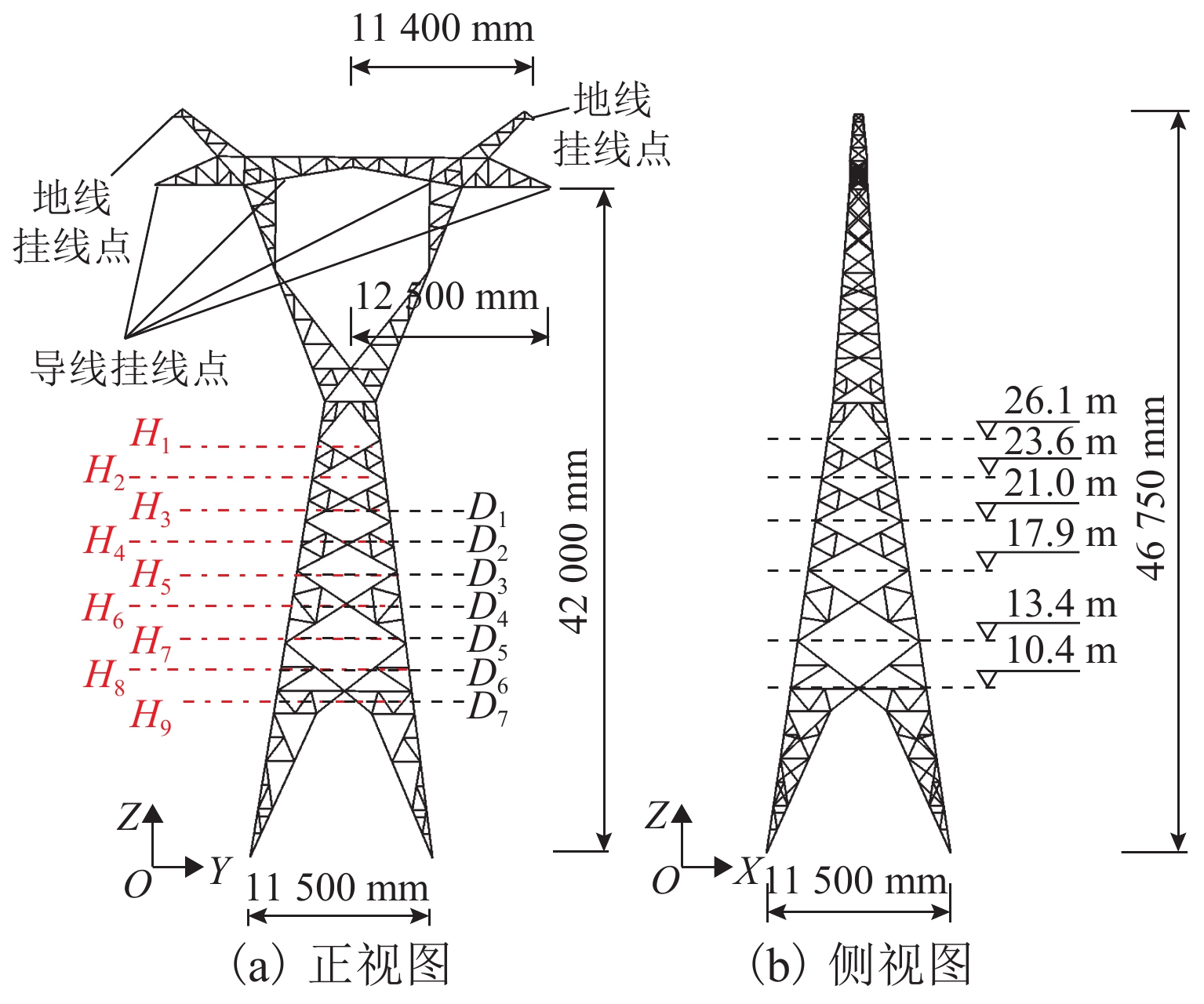
 下载:
下载:


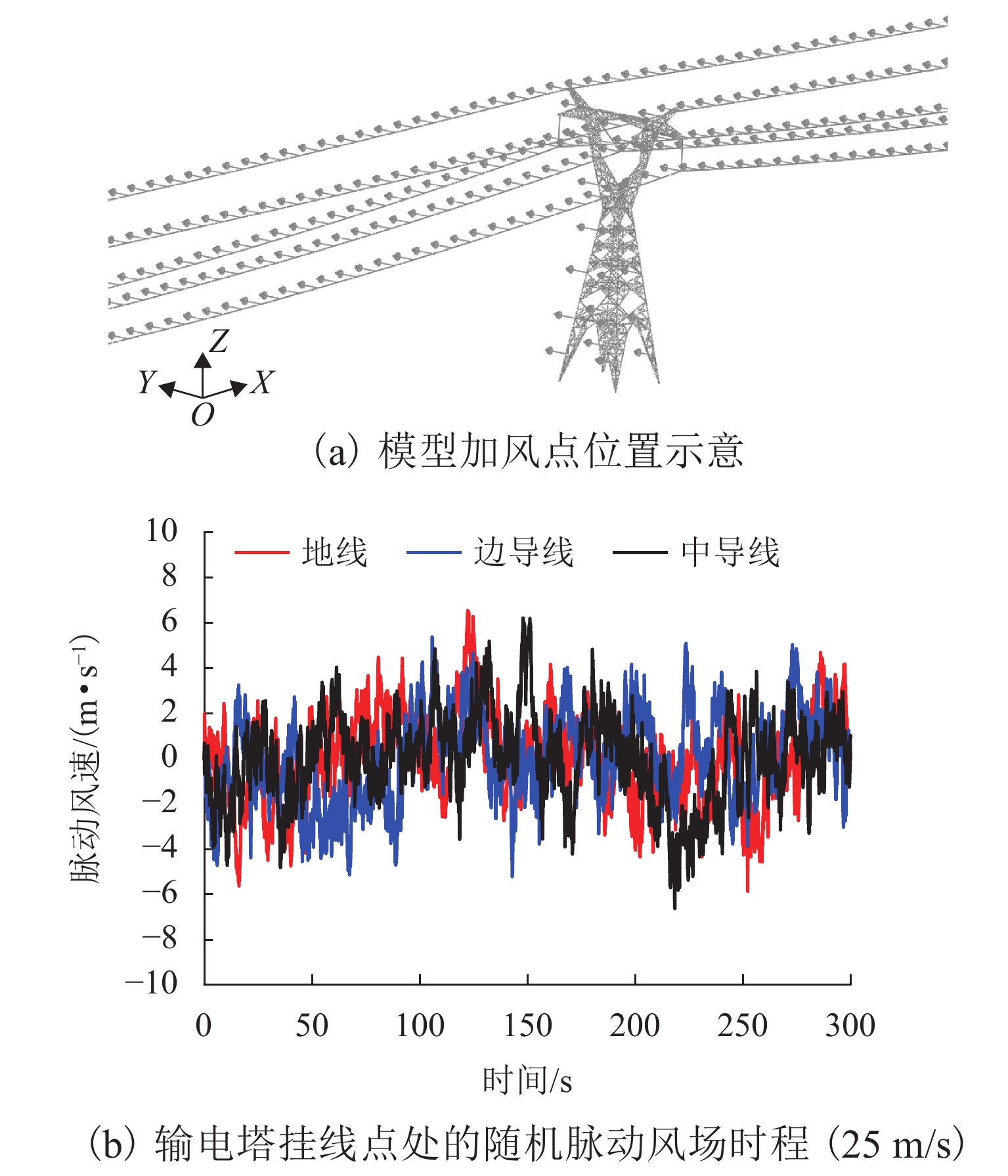
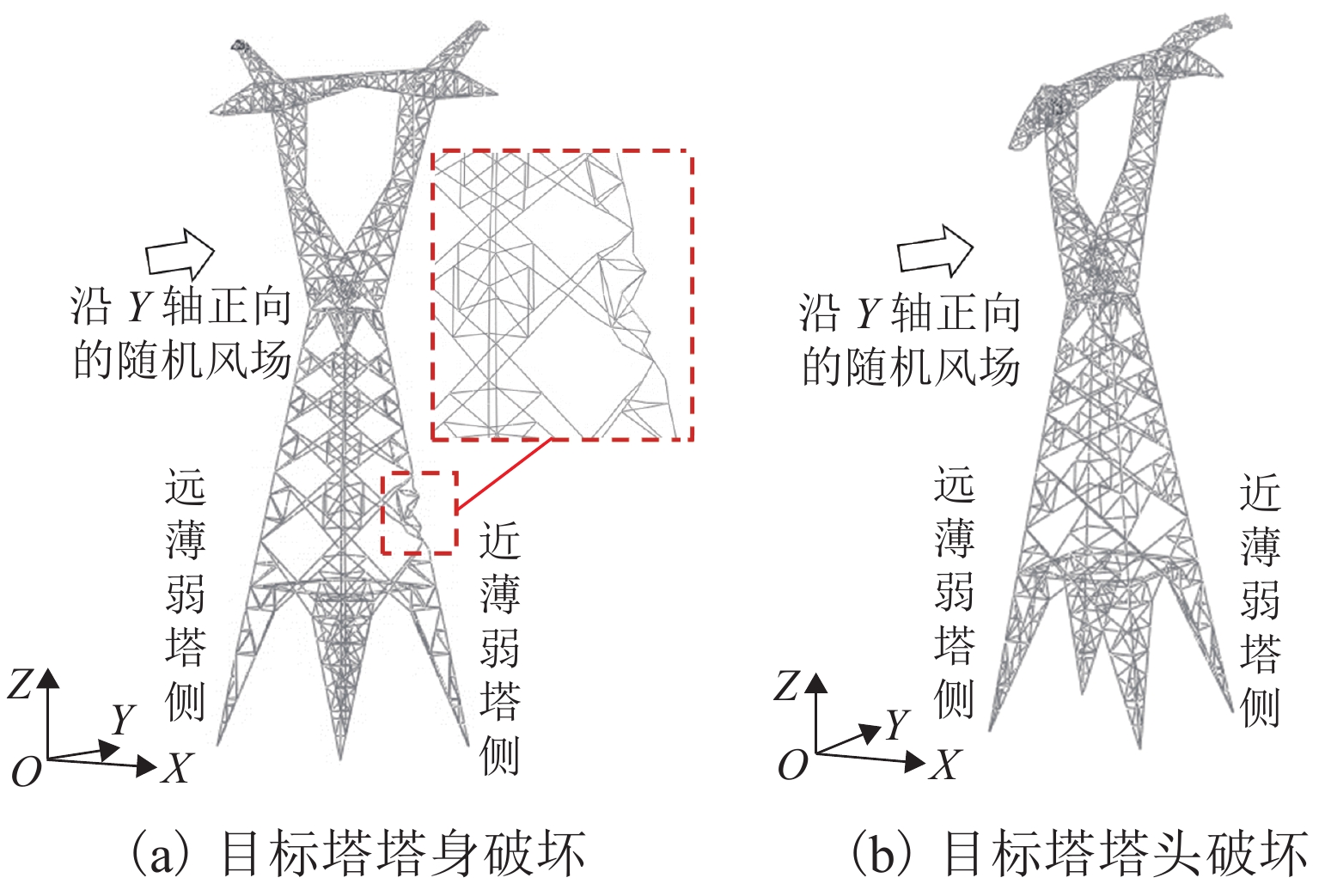
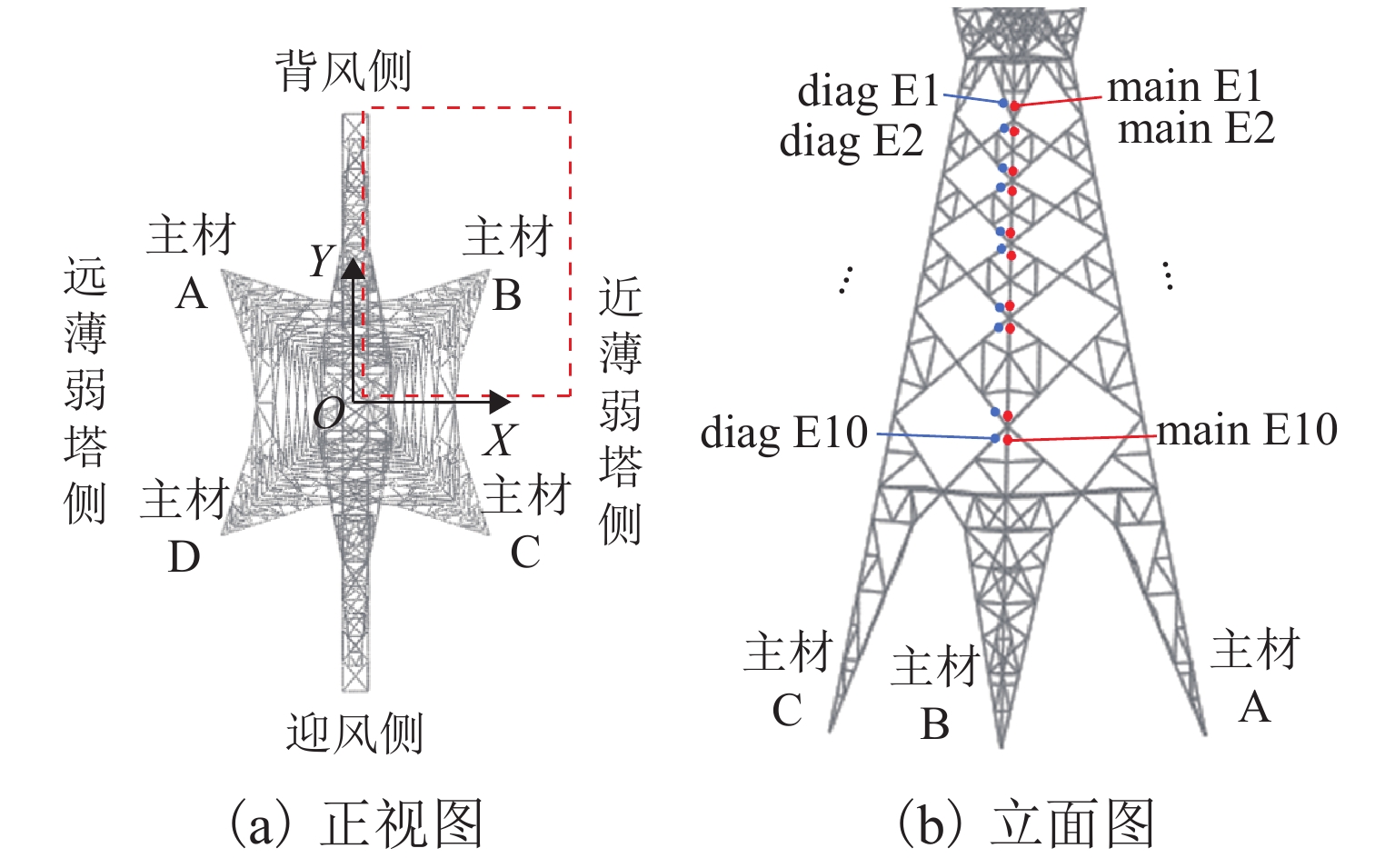

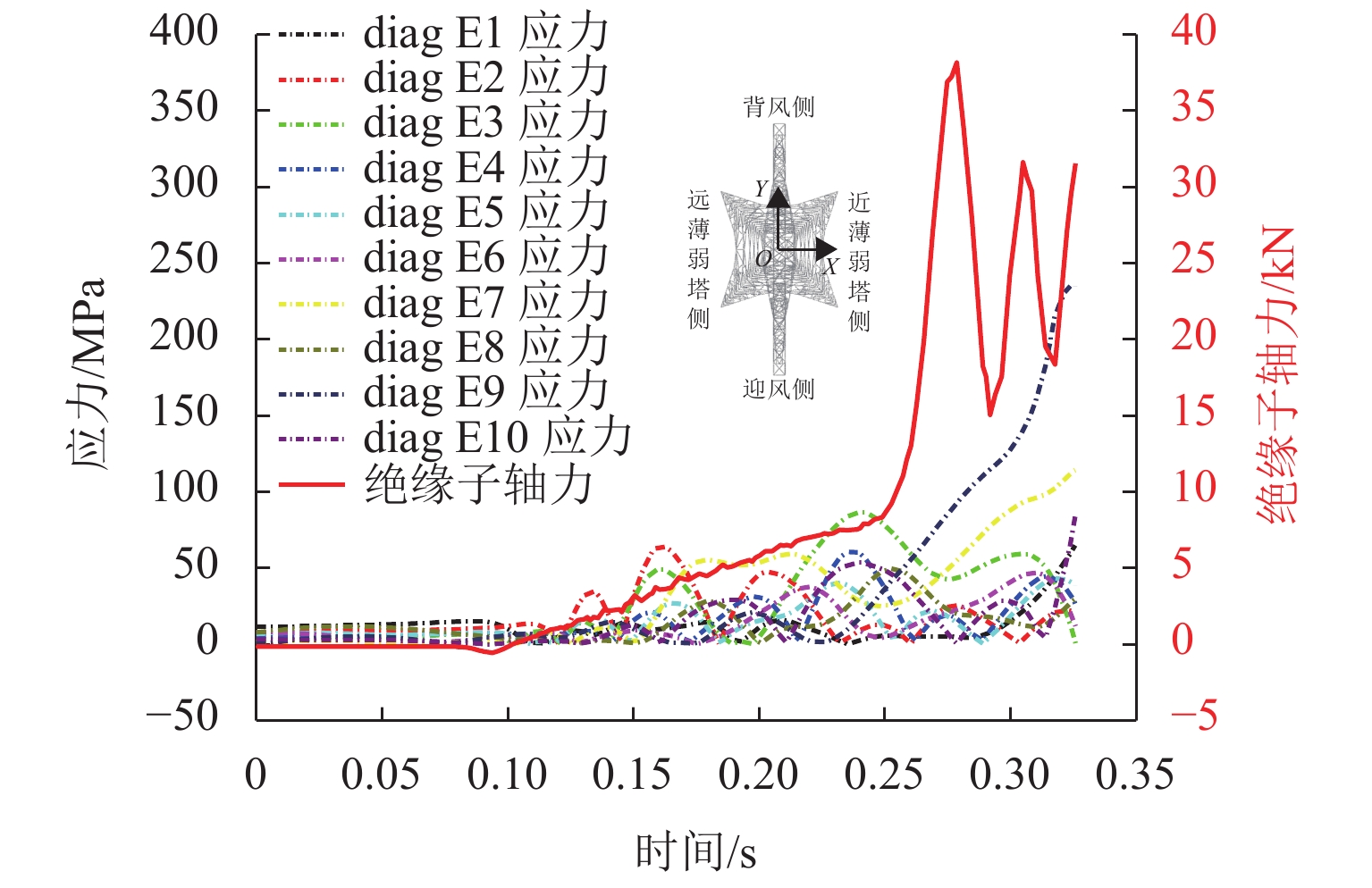
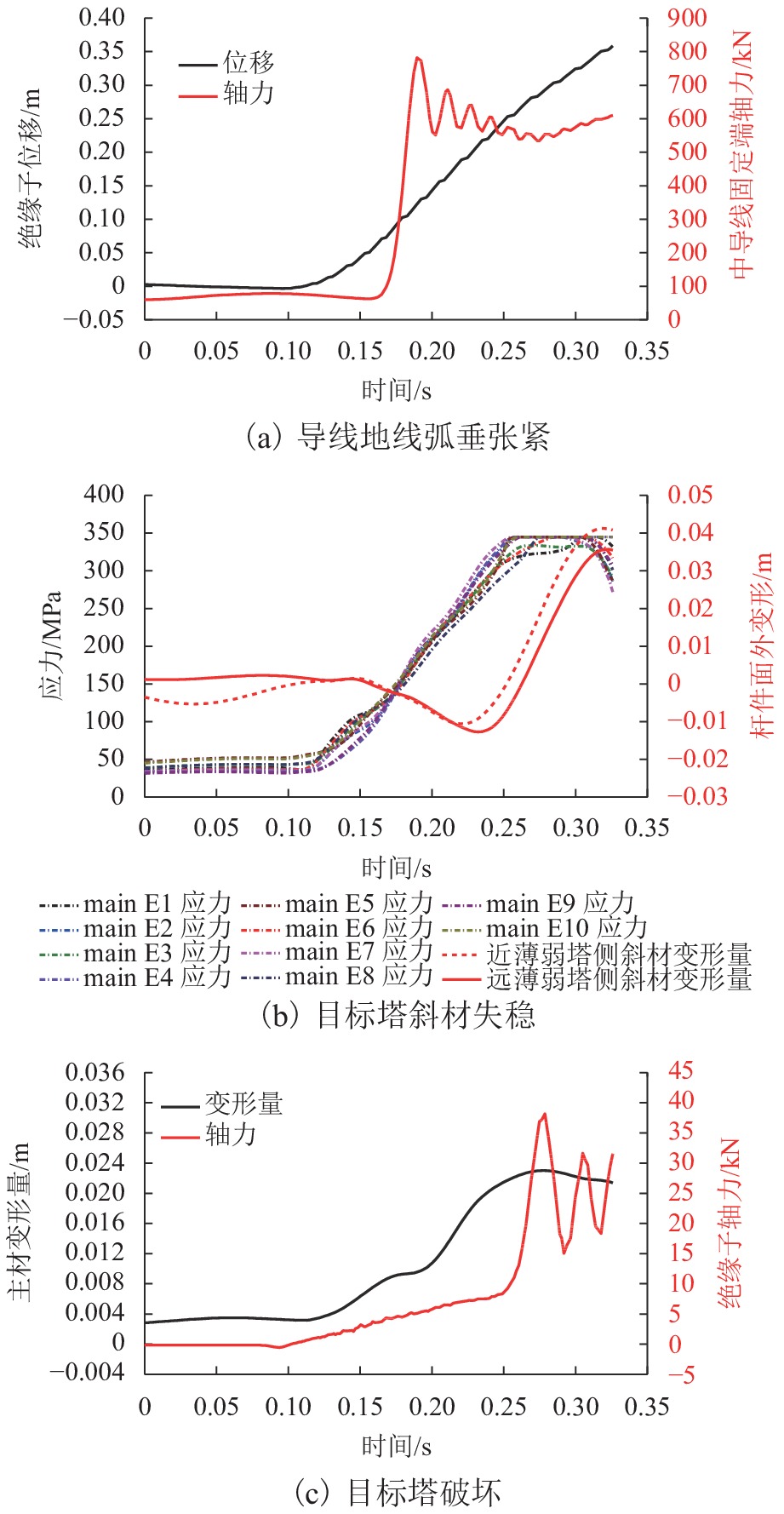
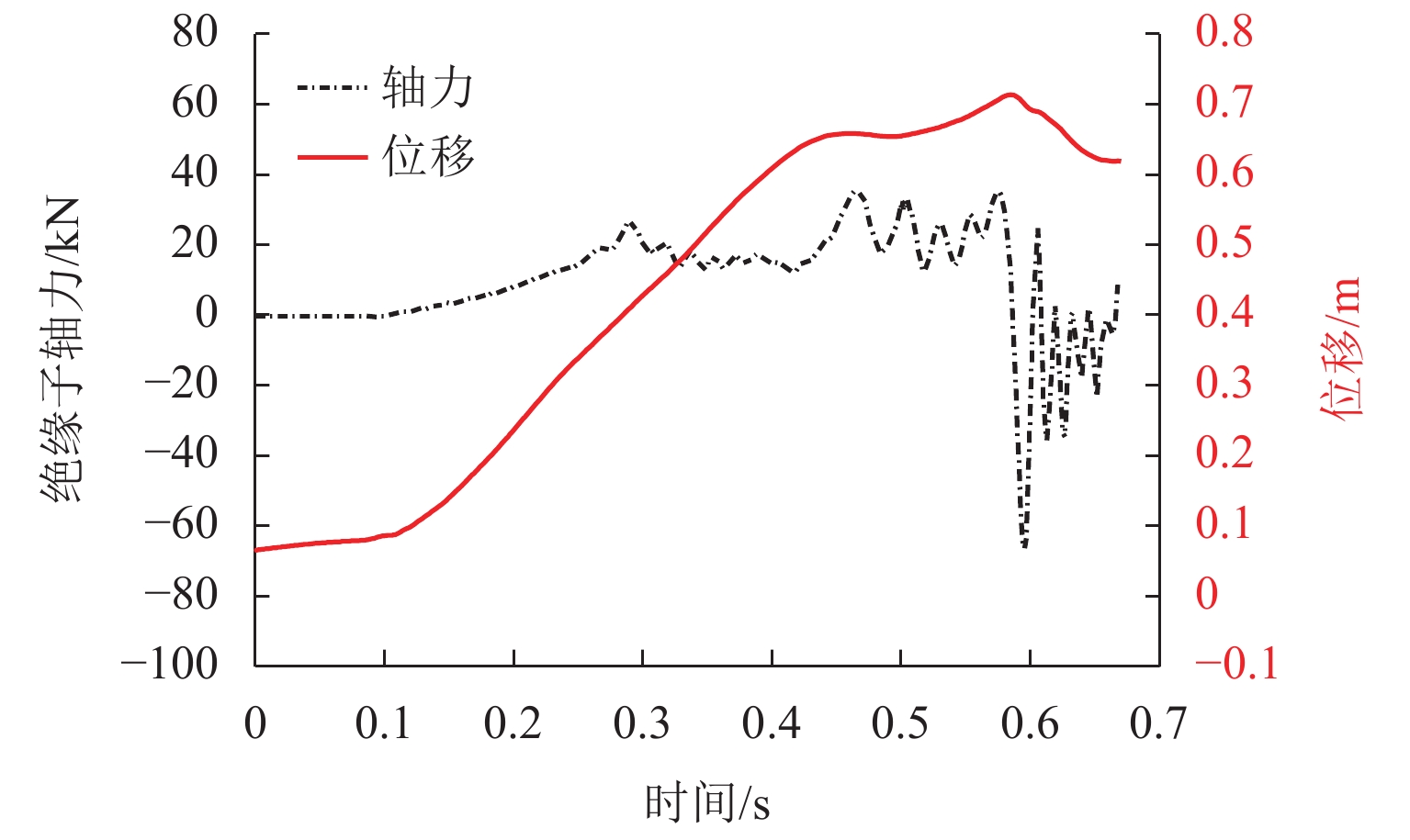
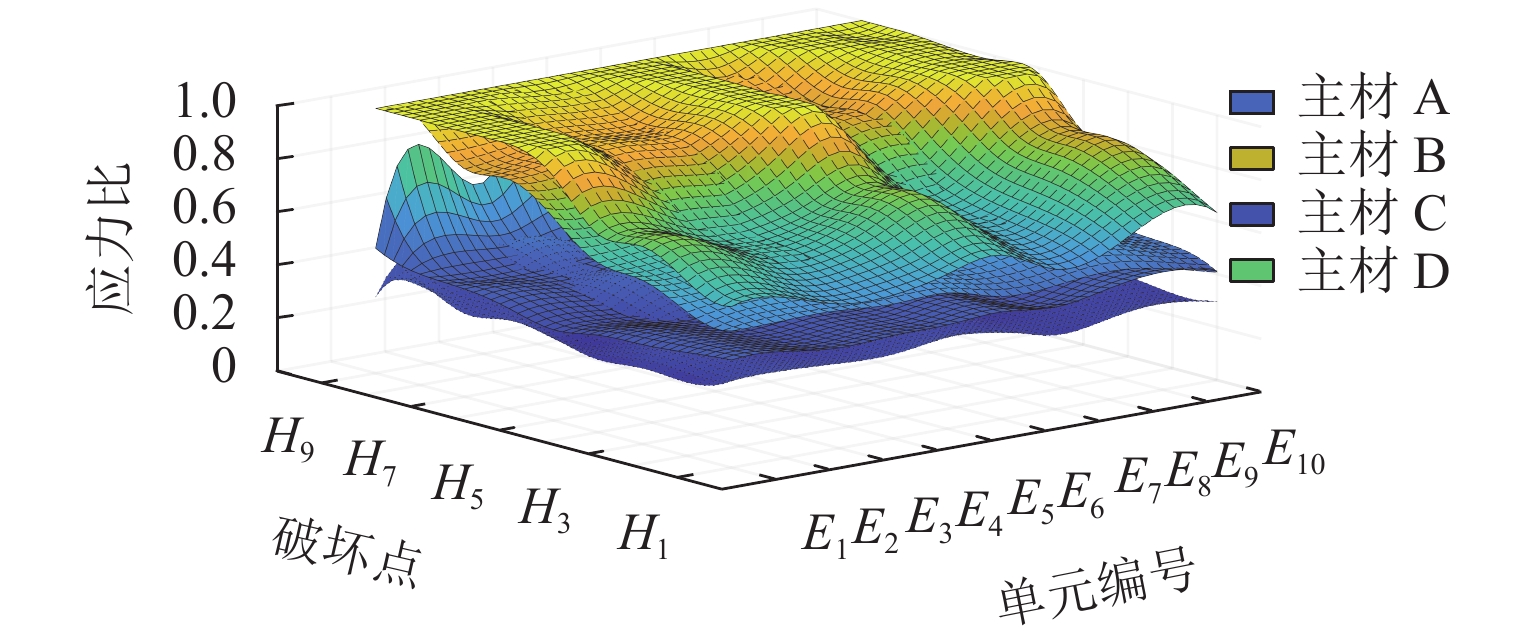
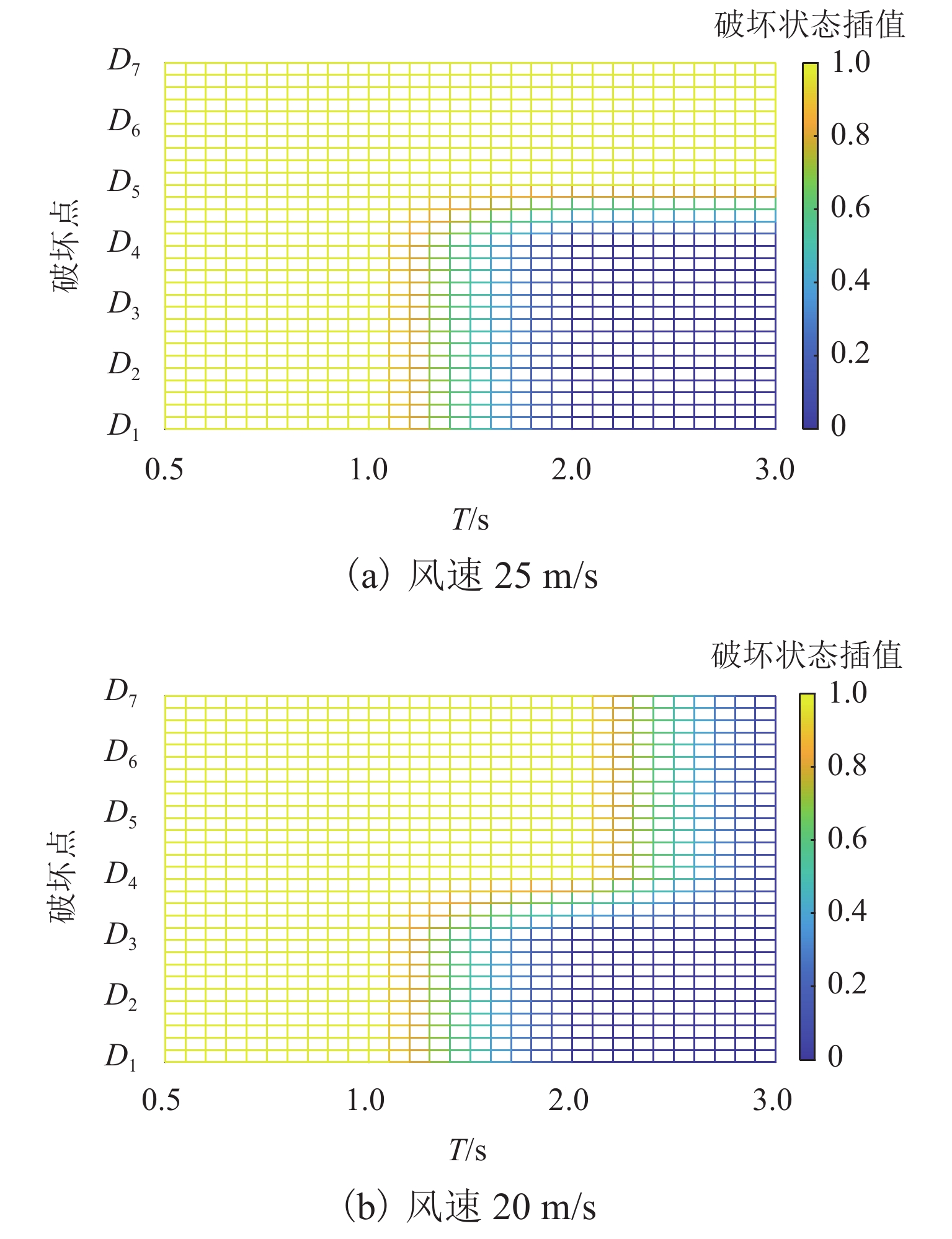
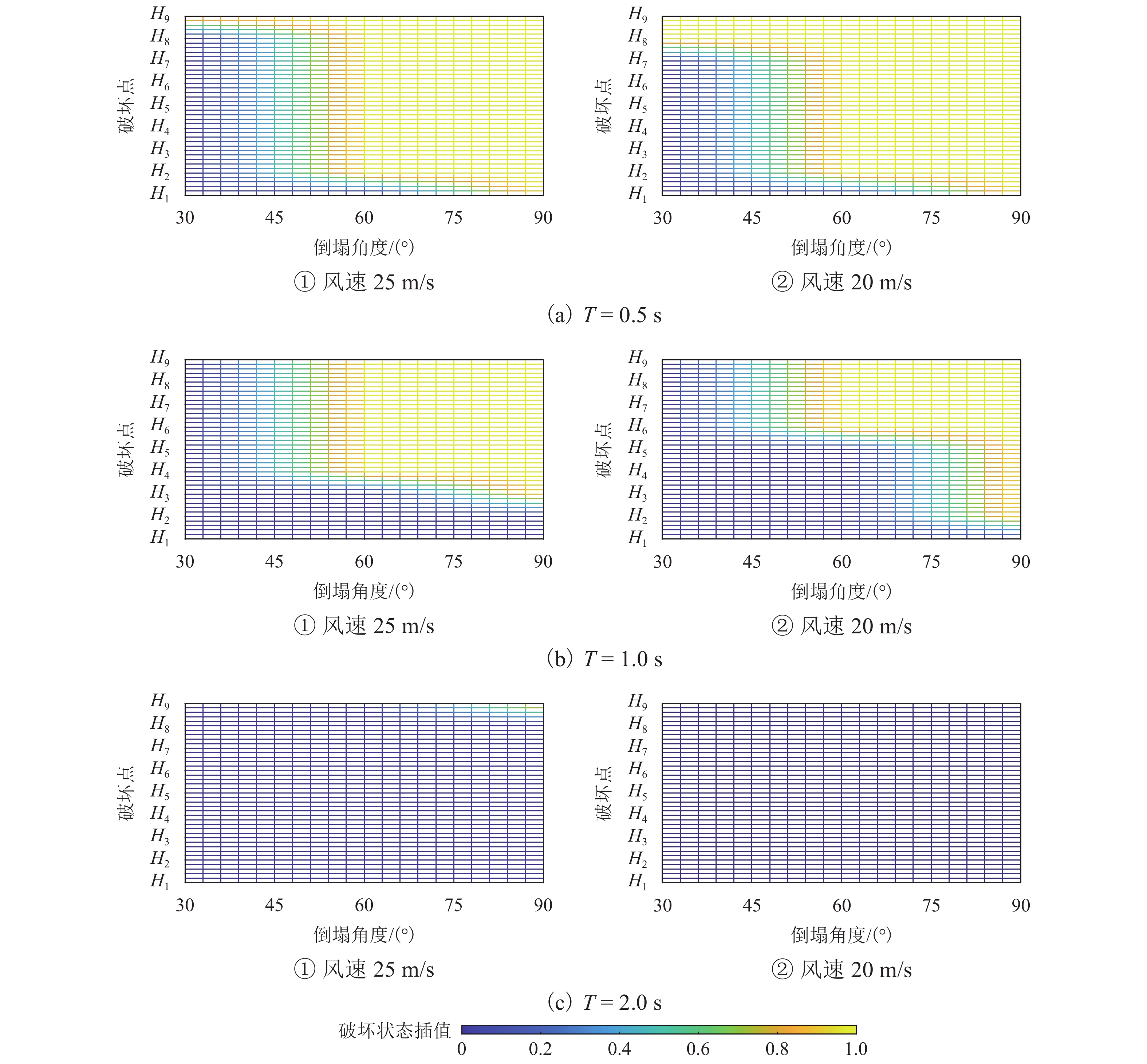

 百度学术
百度学术


